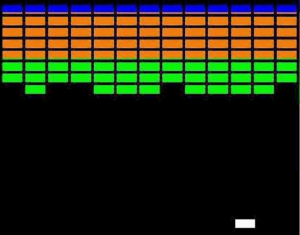
In July 2013, we bought a breakout in US Silica Holdings ($SLCA). Three months later, we sold the stock for an average share price gain of 43%.
In this educational trading strategy article, we use six annotated stock charts to walk you through the entire trade from beginning to end.
Upon finishing the article, you will see that a winning breakout trading system does NOT need to be complicated.
You may even be surprised by how simple our breakout trading technique really is.
Nevermind The Pullbacks, Here’s The Breakout
In a bull market, our momentum swing trading technique primarily focuses on trading both breakouts and pullbacks of leading small to mid-cap stocks.
Depending on market conditions, these trade setups are then entered with a short to intermediate-term time horizon (one week to several months).
Since our last several trade review articles detailed our strategy for buying pullbacks, it is now time to recap an actual breakout trade.
Below is a weekly chart of $SLCA that shows the pattern that had developed just before our initial buy entry:

After launching as an IPO in February 2012, $SLCA rose to the $22 area a month later, then sold off sharply.
As you can see on the chart above, the stock hit bottom in July 2012, then reversed and rallied back to test its prior high in February 2013.
When the price subsequently broke out to a new all-time high in the first week of March (as labeled on the chart), volume immediately spiked higher.
The volume surge was bullish, and confirmed the breakout was backed by the presence of institutional accumulation.
Furthermore, the institutional buying was supported by the fact that $SLCA was also exhibiting strong earnings growth.
$SLCA – Locked And Loaded
After the big breakout in March, the price pulled back for several months, then began building a constructive base of consolidation during that time (click here to see exactly what represents proper basing action).
As the price action began tightening up within the base, it created a downtrend line off the March high.
At this point, the weekly chart was showing a chart pattern similar to a bullish “cup and handle.”
It was at this point that we added $SLCA to our Wagner Daily watchlist and began stalking it for potential buy entry on a base breakout.
Drilling down to the shorter-term daily chart interval, here is our initial buy entry on July 8:

$SLCA established a higher swing low in June, and the next pullback held support of that low. Higher lows within a base is a bullish sign.
Our initial buy entry came after the price broke out above the downtrend line, then confirmed that move by pushing back above its 50 day moving average.
The next chart (same time interval) shows we added shares to the initial position on August 14.
We commonly scale in to stock trades whenever the holding period is expected to be intermediate-term:
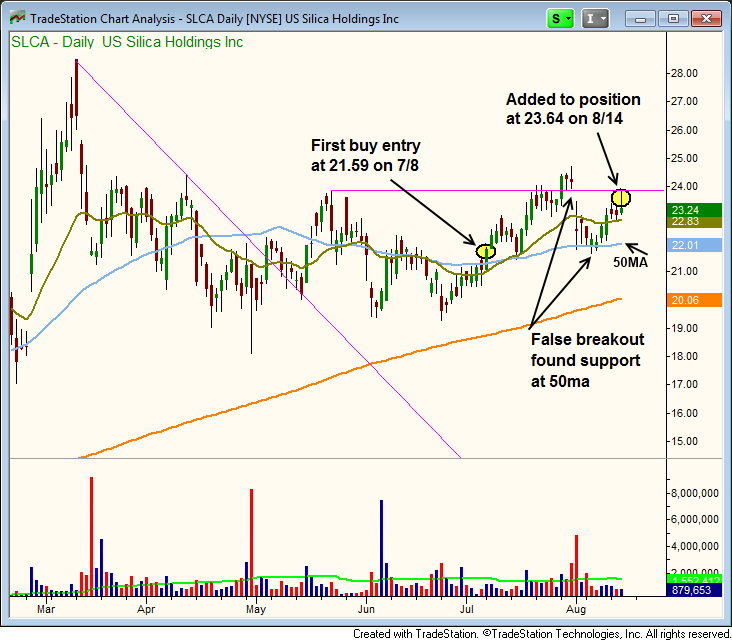
A few weeks prior to adding shares on August 14, $SLCA underwent a false breakout that was triggered by a negative, knee-jerk reaction to an earnings report.
However, after selling off from the false breakout, the price definitively found key support at the 50-day moving average.
Since banks, mutual funds, hedge funds, and other institutions commonly buy pullbacks to the 50-day moving averages in leading stocks, it’s not surprising that the price decline was limited.
As the stock came into support of its 50-day moving average, one could have added to the position at that level with relatively low risk (though we did not).
Once $SLCA began climbing away from its 50-day MA again, it paused for a few days and we added to our position when the price rallied above the two-day high of August 12 & 13.
For the added shares only, we set a protective stop below convergence of the 50-day moving average and prior swing low (stop on original shares remained lower).
Show Me The Money
Fast forwarding about two months, let’s take a look at where and how we scaled out of the trade for a large profit:
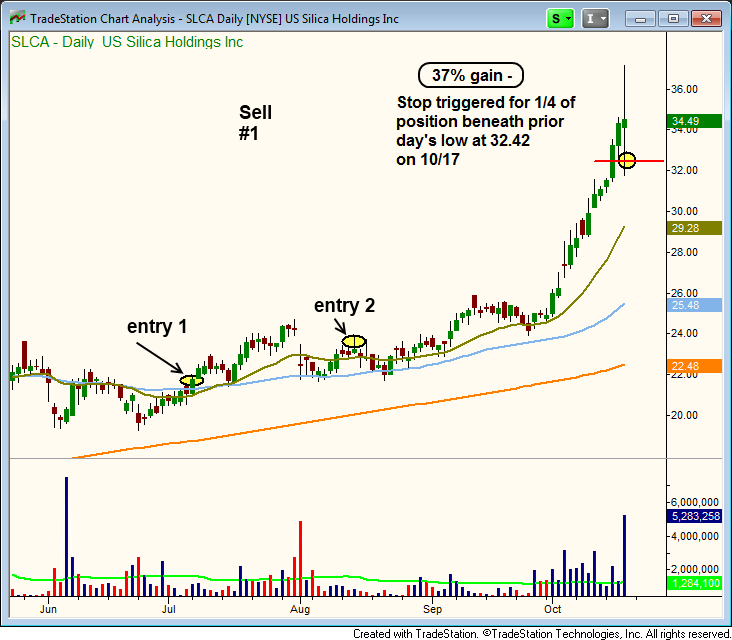
In October, $SLCA really began heating up, as the price broke out to another fresh, all-time high and volume surged again.
Owing to a complete lack of overhead price resistance, momentum kicked into high gear and shoved $SLCA more than 30% higher in the first two weeks of the month.
After the stock rallied to an unrealized price gain of more than 30% from our most recent entry, we trailed a tight stop on 1/4 of the position size, in order to protect gains in case of a sudden pullback.
On October 17, that tightened stop got triggered when the price fell below the prior day’s low (quite a volatile intraday session).
We sold the first 1/4 of our total shares for a gain of 37% (from the most recent entry).
Five days later, we sold another 1/4 of the position, as shown on the daily chart below:
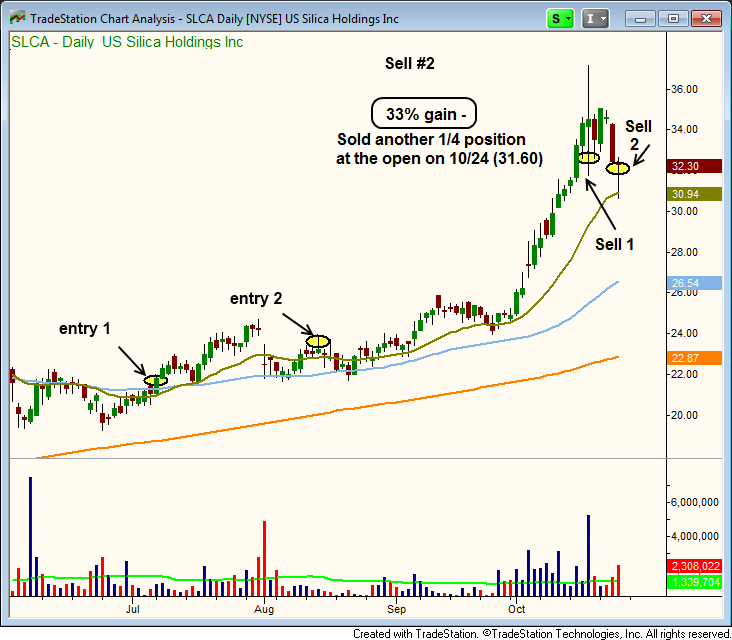 –
–
We continued trailing a tight stop on another 1/4 of the position, rather than selling those shares, just in case the pullback turned out to be very short-lived and the stock broke out to new highs again.
But the stock decided it was time for a breather instead.
$SLCA hit our stop for the second 1/4 of the position on the open of October 24, after stalling at the $35 area for the second time.
This enabled us to score a 33% gain on the second quarter position we sold.
Finally, we sold the remaining half of the position four days later:
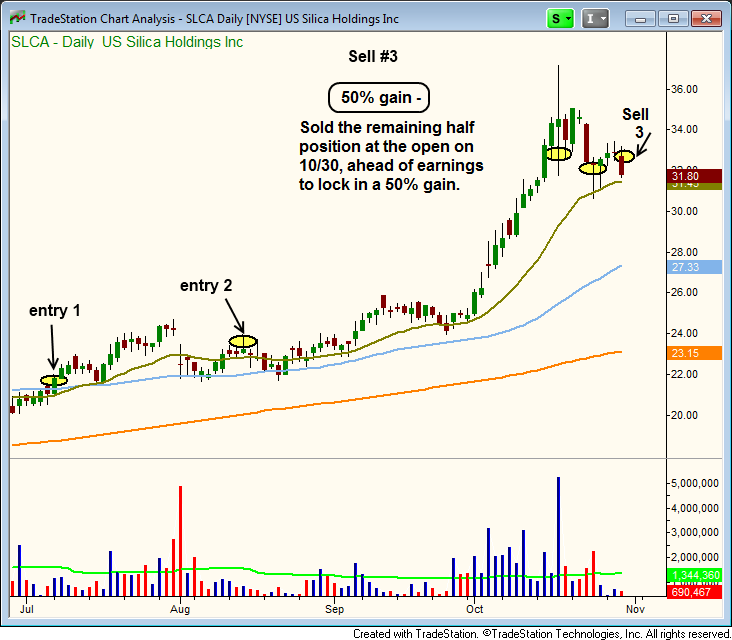
Although we liked the late October bounce off near-term support of the 20-day exponential moving average (beige line), the price began rolling over on October 30.
Since $SLCA was scheduled to report its next quarterly earnings that evening, we made the decision to take the profits off the table that day.
We locked in a very amiable gain of 50% (from the original entry point) on the remaining half position, rather than hold the stock through earnings.
Averaging together the two different entry points and three scaled exit points, this intermediate-term momentum swing trade in $SLCA added up to an average gain of 43%, with a total holding period of just over 3 months.
Don’t miss the next big winning stock pick we hand to subscribers of our nightly swing trading newsletter. Get started now with your 30-day risk-free subscription to The Wagner Daily.
